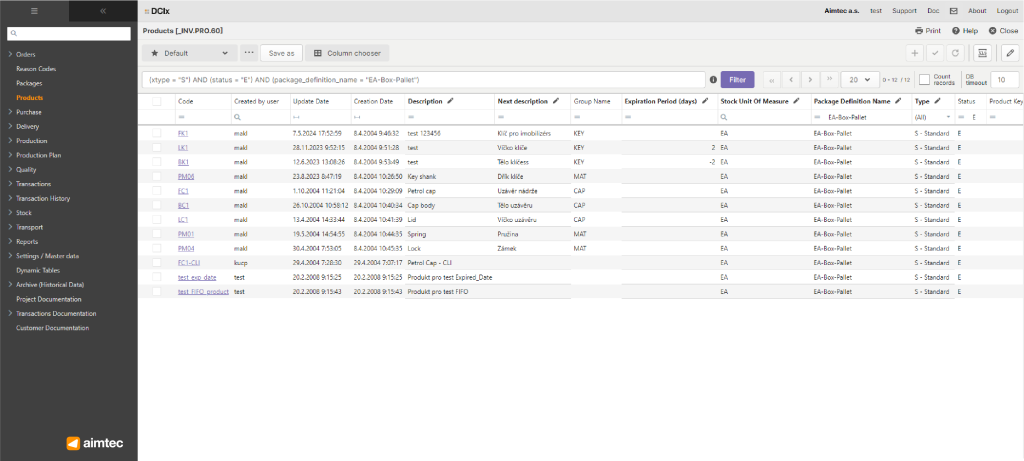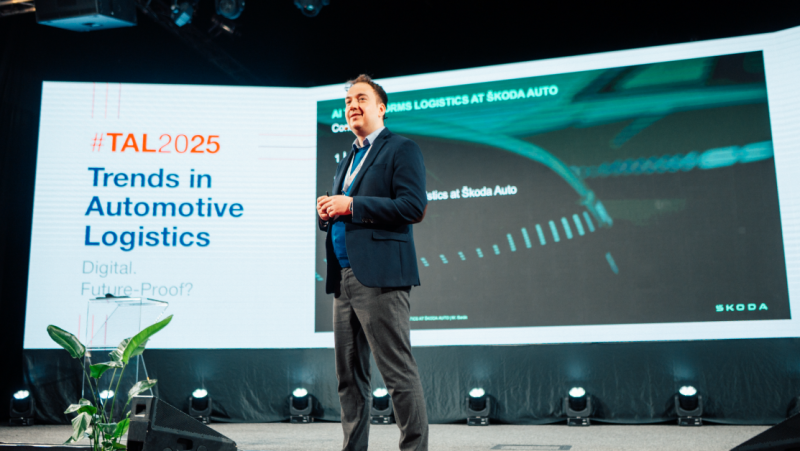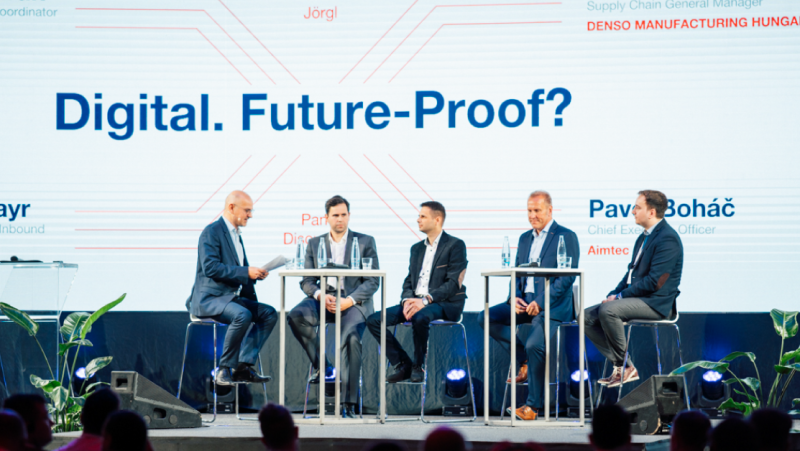Rostislav Schwob: The Latest Aimtec DCIx Version Makes Connected Manufacturing and AI/ML a Reality
- Trends
- Interview
The world around us is constantly accelerating and globalising. That means growing competition, and companies are pushed into ever greater and more frequent changes. New technologies are rushing at them from all sides. It seems like just about everything can be automated now, and everything can control itself with help from digitalisation and artificial intelligence. How can the Aimtec DCIx digitalisation platform help companies with this? And what will our October seminar for customers be showing them? We came with these questions to the person best placed to answer them: Aimtec’s Supply Chain Solutions Director Rostislav Schwob.
Rostislav, everything can seem so complicated and over-technologised these days. It’s harder than usual to bring new things to life. How can you assist logistics and manufacturing firms and offer them the confidence they need?
Within large digitalisation projects, we step into the role of integrator for the available technologies and systems. Our solution, Aimtec DCIx, controls it all and integrates it into a single whole, thereby simplifying work for our customers. We deliver systems that are already functional. Clients don’t have to take care of them; we handle that part. They don’t need any experts and can “just” use the solution. We plug the needed technologies, sensors and existing systems into the system simultaneously, and the integration works. Our solution is fully configurable, so that customers can develop it on their own, without being dependent on us. Through this they become a part of our team, sharing a role in defining the future of their system.

If you were to list the main trends in current development, in the eyes of you and your team, what would they be?
First I have to mention comprehensively connected manufacturing, in which machines, tools, parts, moulds, materials and people all communicate together. By people I mean workers in manufacturing, logistics and quality, in the positions of operators, leaders and foremen. Commands, instructions and parameters are passed along in real time and are evaluated retroactively without human intervention. This ensures that the whole process is error-free. The people or machines know what they should do, and various sensors or cameras check that it actually happened. Moving on from this, new space is opening up for the application of artificial intelligence (AI). This entire area has currently unused potential. Today it is for example possible to evaluate images and with their aid identify various defects in real time. The third thing is work with data.
„The currently often mentioned field of artificial intelligence does have applications in quality control.“
Rostislav Schwob, Supply Chain Solutions Director, Aimtec
Data forms the foundation; it’s an enormous source of untapped know-how for companies. It’s important to monitor it, evaluate it and optimise it. Last but not least, I shouldn’t forget about automation, since this subject has relevance for companies of all kinds – manufacturing, distribution or trading. With every new technology there comes the question of how to connect it, control it and integrate it into the current solution.
You’re talking about trends that we encounter in a number of industry articles if nowhere else. But can you be more specific – how might they be applicable in real-world practice?
I can give an example from the area of comprehensively connecting manufacturing. Imagine a work site where a worker is installing a product equipped with a clear identifier. The operator is holding a tool that is connected over a wifi interface to the system and thus receives the relevant programme. The system know which specific product should be made, and with which parameters. It checks that the logged-in operator on the site has the corresponding qualification and has been trained in all the necessary procedures. Using sensors placed in the tool and the product, it precisely identifies their positions and is able to check that the person is making the installation in the correct location. Once the installation is finished, a check is run to ensure that all the prescribed parameters have been respected; this check is independent of humans and does not require the entry of further data. The benefit of this connected manufacturing approach is a guarantee of 100% quality and detailed product traceability.
We can speak similarly about the use of a sensor that is essentially a general image-processing camera. With the help of machine learning (ML) methods, it’s possible to evaluate its images and find defects, scratches, depressions, bad part colours and shapes, missing parts etc. Checking of correctness thus takes place systematically right at the work site.
You mentioned connected manufacturing and the use of AI/ML primarily in this area. What about logistics – what key trends is Aimtec DCIx supporting?
Here we’re unambiguously talking about automation, and by this I don’t just mean connecting technologies, but also processes. In the new versions of our system, we work with task management, i.e. every request from logistics gets split up into a number of sub-tasks, which we can then place into a number of various queues. We can automatically assign or change priorities for tasks. We are able to isolate a set of tasks, have it optimised and sorted by a smarter algorithm using mathematical functions that seek the minimum function, or in the case of machine learning, find connections. We have verified that if we approach a task in this way, we can shorten the task completion times by a further 10 to 15% and increase the whole application’s performance.
„Data amounts to an enormous treasure chest for process optimisation.“
Rostislav Schwob, Supply Chain Solutions Director, AimtecThe subject of data analysis and simulations ties into optimisation. In the new version, we know how to build a data warehouse, upon which advanced reporting can be run. Users can see the greatest bottleneck, the place with the greatest reserves, and they can know what to focus on. When seeking the optimum, we utilise simulations. Before anything physical gets built, as long as know the times and parameters, we’re able to simulate the processes and say at what performance level the system will run. And maybe the most interesting thing here is being able to compare two variants and say how much they differ from each other and which one is more efficient.
Likewise, for the area of logistics, we look for pilot projects where it’s possible to use AI/ML. Automatic stocktaking can serve as one example. We’re able to replenish the shop-floor supermarket with help from a camera. The operator doesn’t do scanning; instead, the camera evaluates the supermarket’s status, and if there are insufficient materials, it generates a request for their replenishment.
What will the system’s latest version bring to customers in all of the mentioned areas? What are the key changes?
We want the system to still be around even ten years from now, and so we’re approaching it accordingly and modernising it on the inside. That’s why at the User Group meeting in October of this year, we’ll be presenting Aimtec DCIx, version 8, which brings greater security and application availability and reliability and contains all the features I’ve mentioned. Already since version 7, DCIx is built for operation in the cloud in the form of SaaS. Now we’ve expanded the application to make use of Amazon S3 (Cloud Object Storage), where large quantities of data connected with our application or any other can be stored long-term. With our transition to the cloud, we have stopped making use of Microsoft’s SQL Server Reporting Services (SSRS) and transitioned to the more advanced Power BI.

We have wrapped the entire application in interfaces – APIs – which accept connections from their surrounding systems. We have rewritten the application’s interface for the Angular framework with the aim of greater security, modernity and future sustainability. In the application, customers newly have the possibility of showing graphs – EChart – and can customise the environment on their own, for example, change descriptions or transaction names and set various languages. We’re testing the use of AI for our own purposes. We use Copilot for faster coding. We have a vision of developing a similar tool for configuring processes and transactions as well, and we’re testing the use of a chatbot for faster and easier access to information. In the background of all these changes, there has been a modernisation of the technologies that the whole system runs upon.
Can you describe new features in specific areas, that is, in logistics, manufacturing and quality control?
In logistics (the WMS), I’ve already spoken about task management. We’ve added integration into further equipment and technologies. In manufacturing (MES), the system knows how to communicate with other machines and equipment over the MQTT (Message Queuing Telemetry Transport) protocol. In quality, and especially inter-operational quality, we use the four-eyes method, i.e. a second worker must approve each check that is made.
What can you look forward to in the new version of Aimtec DCIx?
We’re bringing you an overview of selected system changes compared to previous DCIx versions.
Share article
Top stories from logistics, production and IT.
Subscribe to Aimtec Insights
By registering, you agree to the processing of your personal data by Aimtec as described in the Privacy policy.
Get top stories and articles
from Logistics, Production and IT.
Subscribe to Aimtec Insights
By registering, you agree to the processing of your personal data by Aimtec as described in the Privacy policy.







